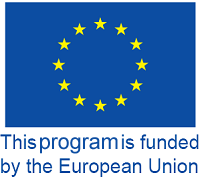FAQ
| QUESTIONS | ANSWERS |
|
As a rule, all visual identity elements must be in the same language as the material is written.
In this specific case, when the material is bilingual or trilingual, all visual identity elements must be in English language. |
|
As a minimum, links to the Programme and the European Commission should be attached and all visual identity elements have to be used, according to the Section 6. Compulsory information from the Annex 3 of the Visual Identity Manual. |
|
The following visual identity elements should appear on all materials produced in the context of a public event so that those attending EU-funded training courses, conferences, seminars, fairs, exhibitions and workshops should be made aware that the EU, through the RO-UA-MD Programme, is financing the event:
– EU flag; – Programme logo; – webpage of the Programme; – key phrase; – general statement of the Programme; – title and MIS ETC Code of the project |
|
The stickers for vehicles/ equipments/ furniture must be drafted in English and in the local language of the beneficiary/ partner. (different stickers, not bilingual).
|
|
The agreed trilingual version of the written identity elements approved by the Joint Managing Authority is provided on the Programe’s website (http://www.ro-ua-md.net/index.php?option=com_content&view=article&id=435&Itemid=332)
|
|
The JMA has received few requests for reallocating the advance payment distribution between the partners, in order to ensure the efficient performance of the funded Action.
JMA agreed in principle with these measure, aiming on the proper deployment of the resources necessary in the process of implementation. Nevertheless, the Beneficiaries were instructed on the fact that the JMA must be formally notified about the measures taken in this respect, as well as on the fact that the following proper financial adjustments in regards to the funds distribution between the project Partners have to be operated before the end of the Action and in such a way as to not impede on the project activities’ timely and efficient completion. |
|
The amounts included at the contingency chapter can be used based on a proper justification in this respect, after concluding an addendum to the grant contract. |
|
In order to obtain the building permit, the legislation of the country where the investment will be implemented is to be respected. At the same time, the provisions of the grant contract (including initial Application) should be checked, in order to assess the compliance of the investment’s actual requirements with the grant contract. |
|
Purchased goods may be transfer from one partner to another in the conditions stipulated in the grant contract (Application, relevant provisions within Special/General Conditions). The JTS and JMA should be informed, accordingly. |
| 10. Which are the most common errors made by beneficiaries which led to the ineligibility of expenses? | – Amounts reported are unjustified or only partially justified by support documents;
– Exceeding the limit values of budget lines; – Exceeding the unit rate or failure to comply with the units number provided within each budget line; – Requesting a VAT settlement in situations where those partners are exempt from paying this tax; – Losses from reported foreign exchange differences; – Failure to comply with national legislation on the values established for internal and external displacements in public institutions; – Salaries paid for a number of hours higher than those worked in reality; – Per diems given to other persons than those provided in the application for funding or budget; – Wrong distribution of expenditures in the budget lines during the reporting period (e.g. design works in the service line); – Doubling the reported costs; – Administrative expenditure exceeding the share contractually established; – Payments exceeding the amounts indicated in the procurement contracts (cost, units, number of units); – Payments for goods or services that weren’t stipulated in the budget; – Using amounts allocated to per diems for other purposes (e.g. payment of intermediary services); – Misused inforeuro /medium rate. |



